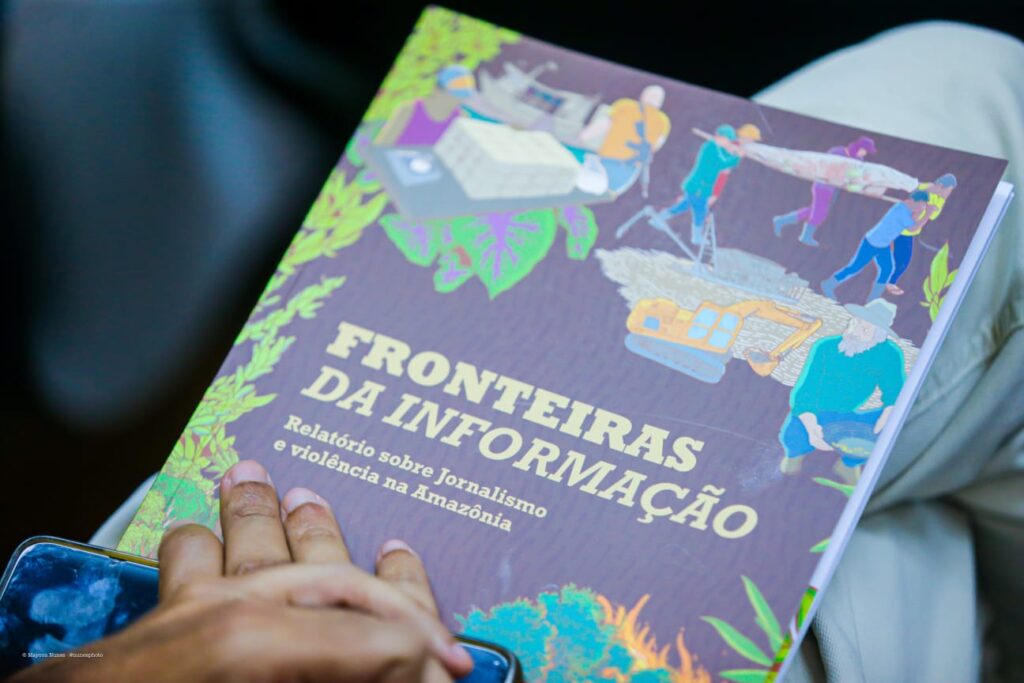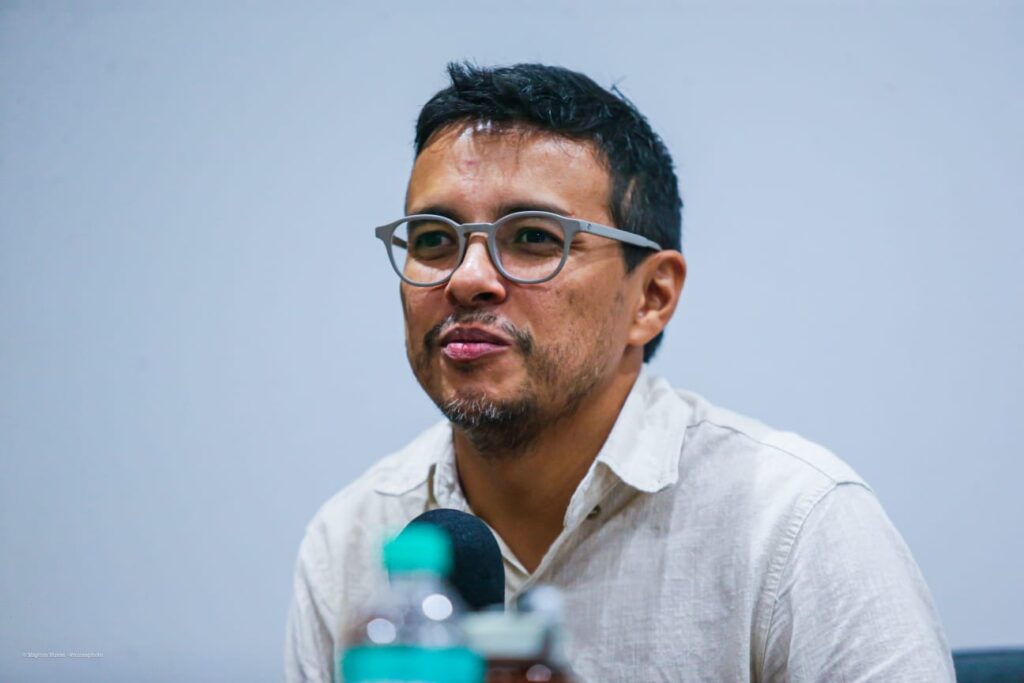“There will be no forest if there is no one to defend the forest.” The phrase is from Darlon Neres, a 23-year-old communicator threatened for reporting on illegal logging in western Pará, a state in northern Brazil. In September 2023, he had to leave the community where he lived and received a police escort under the guidance of the Federal Public Ministry.
Neres is one of ten journalists and communicators quoted in a recent report from the Vladimir Herzog Institute (IVH, for its acronym in Portuguese) who said they were threatened and attacked for reporting on predatory activities in the Brazilian Amazon. “Fronteiras de Informação” (Information Frontiers) brings to light the stories of these professionals and highlights the connection between violence against the press in the region and the destruction of the forest. It also offers safety tips for journalists and presents protective resources that professionals can turn to if they are in danger.
The report also compiles data from the National Federation of Journalists (Fenaj), which recorded 230 cases of violence against the press in the nine states of the Brazilian Amazon between 2013 and 2023. Pará is the state with the most records (89 cases), followed by Amazonas (38), Mato Grosso (31) and Rondônia (20). The year 2022, when then-President Jair Bolsonaro was running for re-election and was defeated by Luiz Inácio Lula da Silva, was the year with the most registered cases: 45.

The report was launched on April 23 during an event in Belém, Pará. (Photo: Maycon Nunes / Instituto Vladimir Herzog)
Dyego Pegorario, coordination supervisor at IVH and the National Network for the Protection of Journalists and Communicators, told LatAm Journalism Review (LJR) that the scenario of violence against communicators in the Amazon has become more complex in recent years. Particularly after the murders of Brazilian Indigenous affairs expert Bruno Pereira and British journalist Dom Phillips in June 2022, organizations defending press freedom understood that it was necessary to look at the Amazon “with greater focus,” he said.
“Based on this need, we established strategies to better understand what this scenario is like today. This report addresses that. We want to build this slightly broader and more current understanding of the challenges present in the Amazon for journalists and communicators,” he said.
Economic powers against journalists
Journalist Hyury Potter, born and raised in Pará and dedicated to covering the Amazon, edited and coordinated the production of the report, which was also supported by two other reporters, Fábio Bispo and Ariene Susui. By listening to journalists' stories, the team sought to understand the context of the threats.
“Whenever the person was being threatened, it was usually an economic power, some economic activity that was behind it, that financed it. When this communicator or journalist bothered this economic power, threats came. So we started to relate [threats] to economic activities that are blatantly illegal or some that are suspected [of illegality], such as cattle ranching [on Indigenous lands], logging, mining,” he told LJR.
Mining, according to the report, is the economic activity behind threats and attacks on several journalists in Roraima. The state is where most of the Yanomami Indigenous land is located, where the explosion of illegal mining caused a humanitarian crisis during the years of the Bolsonaro government (2019-2022) that has not yet been resolved by the current Lula government.
Indigenous lands in Brazil, referred to with the letters TI, are constitutionally-protected territories where Indigenous peoples traditionally lived and currently reside.
Journalist Emily Costa was among those who had to leave Roraima due to the threats.
“I lay down to sleep in my room and remembered a mining leader who has millions of Reais, who has several helicopters, a lot of money, armed henchmen, farms, and really has a large structure. He had and has, because he’s still free. And I looked at the crack in my door, in my room, and I thought how easy it would be to enter my house and take me, because security was practically zero,” she said in the report.
In the case of Neres and the digital media outlet Tapajós de Fato, the threats came after reporting on illegal logging in the Santarém region, in Pará.
“Communicating in the Amazon is very challenging. You have no security, you are at their mercy. We need to improve defense instruments for these communicators. Sometimes we have to spend two days on a boat to be able to give voice and visibility to those communities. And we were able to tell what was happening there, that they were being threatened. When a communicator is threatened and violated because they reported illegality, we don’t know who to turn to,” Neres told the team.
Livestock farmers within the Uru-Eu-Wau-Wau Indigenous land were responsible for a siege on Indigenous communicators in May 2023, according to the report of Indigenous leader Txai Suruí.
A group of Indigenous communicators from the territory and a documentary team from the United Kingdom were on their way to record a kind of artistic act against the invasion of land by cattle ranchers. Around 50 men, some armed, surrounded the group on the road and prevented them from continuing their journey for five hours, Txai Suruí said.
She said that the men were surprised when they saw the Indigenous people with cameras filming as they surrounded them. She considers the actions of the men to have been “premeditated and organized.”
“The filmmaker who was with us had two big cameras. He started filming people. That scared them, actually scared them,” she said in the report.
In addition to these cases, the document contains accounts of judicial censorship of articles, threats against journalists by environmental inspectors and police, and a shooting attack on the headquarters of a news website in Rondônia.
Potter, responsible for the report, has also experienced situations in which he felt at risk while doing his work in the region.

Journalist Hyury Potter during the launch event of the report in Belém, Pará . (Photo: Maycon Nunes / Instituto Vladimir Herzog)
“Unfortunately it happens quite often, if you travel to the Amazon and are investigating some type of illegal [supply] chain,” he said.
“In 2021 I went to airstrips used for mining for an investigation (...) Some situations were very strange. On a farm, the security guard was surrounding us. It wasn't friendly at all, we were in the middle of nowhere, right? (...) In another situation, I went to talk to a pilot and knocked on the door of his house, on the side of the airstrip. He came out with a gun in his hand. I said 'Hi, how are you? You don’t need a gun’ and such. I tried to stay calm, but inside I was scared to death.”
Potter pointed out that, although some media outlets have developed security protocols for their journalists in the field, “there is no general security protocol for journalists and communicators traveling in the Amazon.”
"This is a problem. Newsrooms have to work better on this,” he said.
He also recalled that newsrooms do not have psychological assistance policies for trauma that journalists may suffer when threatened or experiencing risky situations in the field.
“We still have a long way to go on this,” Potter said.
Restructuring public policies
The report also analyzes the two main public policies to protect journalists and communicators in Brazil: the Program for the Protection of Human Rights Defenders, Communicators and Environmentalists (PPDDH), created in 2005 and which began to include communicators and journalists in 2018, and the National Observatory of Violence against Journalists, created in January 2023.
Some journalists interviewed for the report reported the threats and attacks they suffered to the authorities, but said they received no feedback on the investigations. At least one of them contacted the PPDDH – and has been waiting for a response for seven months.
“It was evident that there was a slowness in providing care to these people,” Potter said.
He recalled that, in recent decades, many of the defenders of the Amazon Forest who were murdered had denounced the threats and even named their tormentors before dying – the Indigenous affairs expert Bruno Pereira, with whom British journalist Dom Phillips was murdered, is one of them.
“[These deaths] were never a surprise. If you look at the history, this person had already said they were under threat and reported the people who threatened them and nothing happened. This slowness in protection ends up leading to a tragedy,” Potter said.
According to Pegorario, civil society organizations have been able to offer support to threatened journalists, but this support has “a limited approach.”
“The construction of a public protection policy must be the responsibility of the State, and the State must offer the necessary structure for this protection work to be effective,” he said.
He said that Brazil is currently at a time of restructuring existing policies, such as the PPDDH, and building new public policies for this purpose, such as the National Observatory of Violence against Journalists. In this sense, the report offers recommendations for the Brazilian State to improve its initiatives to protect journalists and communicators. There will be an event to launch the report in June in Brasília, when IVH intends to present it to federal government representatives responsible for these public policies.
“Journalists and communicators from the Amazon region have been important in reporting illegal activities and, ultimately, in protecting the forest. It is journalists and communicators who are bringing images and information about the devastation of the forest to the world,” Pegorario said.
“The report brings to light this data and these stories of journalists and communicators threatened in the Amazon region. Based on these illustrative data from the scenario, we will build this dialogue with public bodies to expand both this perspective of protection and this focus that is more on the Amazon region.”